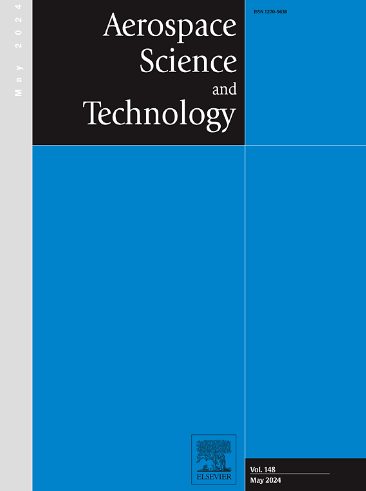Aero-thermodynamic responses of a novel FGM sector disks using mathematical modeling and deep neural networks
IF 5
1区 工程技术
Q1 ENGINEERING, AEROSPACE
引用次数: 0
Abstract
Composite sector disks have extensive applications in aerospace industries, particularly when exposed to challenging conditions such as supersonic airflow and thermal environments. These applications leverage the superior properties of composite materials, including high strength-to-weight ratios, enhanced durability, and excellent thermal resistance, to meet the stringent requirements of aerospace operations. Multi-directional functionally graded (MD-FG) materials due to high-temperature resistance and other amazing properties in each direction have gotten plenty of attention recently. So, in this research, a thermoelasticity solution has been presented to study fundamental frequency traits of an MD-FG sector disk in supersonic airflow via both mathematics simulation and deep neural networks technique. For obtaining exact displacement fields, along with defining the changes of transverse shear strains along the system's thickness, the refined zigzag hypothesis is utilized. For obtaining the temperature-dependent equations, heat conduction relation and thermal boundary conditions of the MD-FG structure are presented. A coupled quasi-3D new refined theory (Q3D-NRT) and generalized differential quadrature method (GDQM) are presented for obtaining and solving the partial differential equations in the time-displacement domain. After obtaining the mathematics results, appropriate datasets are made for testing, training, and validation of the deep neural networks technique. Finally, the results have shown that aerodynamic pressure, temperature changes, Mach number, free stream speed, and air yaw angle have a major role in the stability/instability analyses of the thermally affected MD-FG sector disk in supersonic airflow. As an amazing outcome, increasing the sector angle, FG indexes, and temperature change lead to the reduction of the critical Mach number, and aerodynamic pressure associated with the flutter phenomenon.
利用数学建模和深度神经网络研究新型 FGM 扇形盘的空气热力学响应
复合材料扇形盘在航空航天工业中有着广泛的应用,尤其是在面临超音速气流和热环境等挑战性条件时。这些应用充分利用了复合材料的优异性能,包括高强度重量比、更强的耐用性和出色的耐热性,以满足航空运营的严格要求。多向功能分级(MD-FG)材料由于在每个方向上都具有耐高温性和其他惊人的特性,最近受到了广泛关注。因此,本研究提出了一种热弹性解决方案,通过数学模拟和深度神经网络技术来研究 MD-FG 扇形盘在超音速气流中的基频特性。为了获得精确的位移场,同时定义横向剪切应变沿系统厚度的变化,利用了精炼之字形假说。为了获得与温度相关的方程,介绍了 MD-FG 结构的热传导关系和热边界条件。提出了一种准三维新精炼理论(Q3D-NRT)和广义微分正交法(GDQM)耦合方法,用于获取和求解时间-位移域中的偏微分方程。在获得数学结果后,制作了适当的数据集,用于测试、训练和验证深度神经网络技术。最后,研究结果表明,气动压力、温度变化、马赫数、自由流速度和空气偏航角对热影响 MD-FG 扇形盘在超音速气流中的稳定性/不稳定性分析具有重要作用。一个惊人的结果是,扇形角、FG 指数和温度变化的增加导致临界马赫数和与扑翼现象相关的空气动力压力的降低。
本文章由计算机程序翻译,如有差异,请以英文原文为准。
求助全文
约1分钟内获得全文
求助全文
来源期刊

Aerospace Science and Technology
工程技术-工程:宇航
CiteScore
10.30
自引率
28.60%
发文量
654
审稿时长
54 days
期刊介绍:
Aerospace Science and Technology publishes articles of outstanding scientific quality. Each article is reviewed by two referees. The journal welcomes papers from a wide range of countries. This journal publishes original papers, review articles and short communications related to all fields of aerospace research, fundamental and applied, potential applications of which are clearly related to:
• The design and the manufacture of aircraft, helicopters, missiles, launchers and satellites
• The control of their environment
• The study of various systems they are involved in, as supports or as targets.
Authors are invited to submit papers on new advances in the following topics to aerospace applications:
• Fluid dynamics
• Energetics and propulsion
• Materials and structures
• Flight mechanics
• Navigation, guidance and control
• Acoustics
• Optics
• Electromagnetism and radar
• Signal and image processing
• Information processing
• Data fusion
• Decision aid
• Human behaviour
• Robotics and intelligent systems
• Complex system engineering.
Etc.
 求助内容:
求助内容: 应助结果提醒方式:
应助结果提醒方式:


